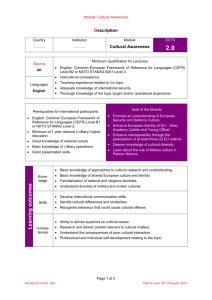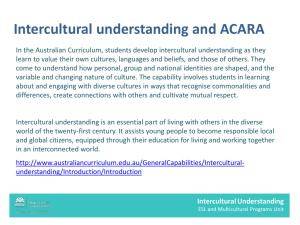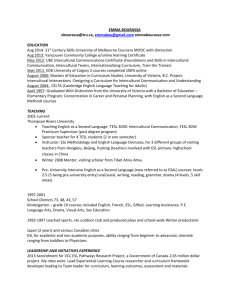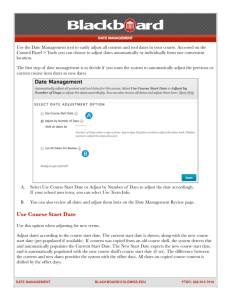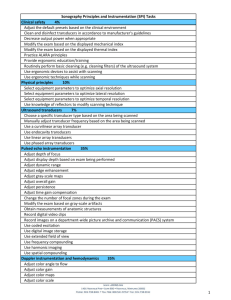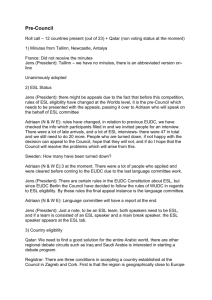DOC - Dixie State University
advertisement
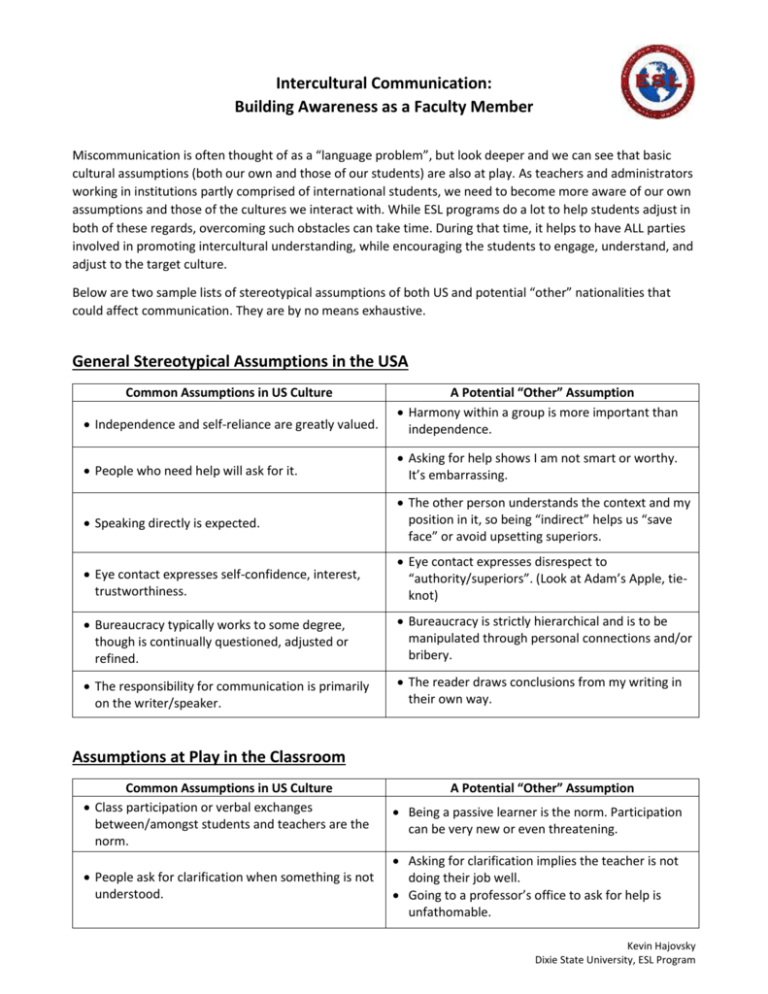
Intercultural Communication: Building Awareness as a Faculty Member Miscommunication is often thought of as a “language problem”, but look deeper and we can see that basic cultural assumptions (both our own and those of our students) are also at play. As teachers and administrators working in institutions partly comprised of international students, we need to become more aware of our own assumptions and those of the cultures we interact with. While ESL programs do a lot to help students adjust in both of these regards, overcoming such obstacles can take time. During that time, it helps to have ALL parties involved in promoting intercultural understanding, while encouraging the students to engage, understand, and adjust to the target culture. Below are two sample lists of stereotypical assumptions of both US and potential “other” nationalities that could affect communication. They are by no means exhaustive. General Stereotypical Assumptions in the USA Common Assumptions in US Culture Independence and self-reliance are greatly valued. A Potential “Other” Assumption Harmony within a group is more important than independence. People who need help will ask for it. Asking for help shows I am not smart or worthy. It’s embarrassing. Speaking directly is expected. The other person understands the context and my position in it, so being “indirect” helps us “save face” or avoid upsetting superiors. Eye contact expresses self-confidence, interest, trustworthiness. Eye contact expresses disrespect to “authority/superiors”. (Look at Adam’s Apple, tieknot) Bureaucracy typically works to some degree, though is continually questioned, adjusted or refined. Bureaucracy is strictly hierarchical and is to be manipulated through personal connections and/or bribery. The responsibility for communication is primarily on the writer/speaker. The reader draws conclusions from my writing in their own way. Assumptions at Play in the Classroom Common Assumptions in US Culture Class participation or verbal exchanges between/amongst students and teachers are the norm. A Potential “Other” Assumption Being a passive learner is the norm. Participation can be very new or even threatening. People ask for clarification when something is not understood. Asking for clarification implies the teacher is not doing their job well. Going to a professor’s office to ask for help is unfathomable. Kevin Hajovsky Dixie State University, ESL Program Everyone understands (or should) what I am saying/implying Slang, idiomatic expressions, and humor can be quite subtle and require a lot of interaction/time to acquire. Some international students may be used to British variants of the language (spelling, syntax, or levels of politeness). Polite nodding and smiling maintain harmony. Students/People should communicate clearly and to the point. Conversations should take into consideration and respect other people’s perspectives and opinions without challenging them. Silence means the student doesn’t have an answer/opinion, doesn’t value his/her education, or didn’t do the homework. Pauses before answering may be common, even respectful. (Cognitive load of language/content can take time to process) Recommendations for Building Awareness It is never easy to objectively see how our own beliefs affect how we perceive and even judge people from outside our cultural spheres. Below are a few suggestions for beginning (or continuing) to develop intercultural communicative competence which can enhance the relationships, attitudes, and success rates of students, teachers, and administrators. Keep a list: Begin maintaining a list of observations, insights, and common issues that arise due to cultural expectations and/or misunderstandings in the classroom. Research and experiment with ways of addressing issues of concern. Share your list and techniques with other educators. Meet the student(s): Require international students to come meet you occasionally so you can clearly articulate your expectations and get to know their views. Use the topics in the T-charts above to question, share points of view, and help them adjust. Be aware that for some students, this alone is quite foreign, so there is value in maintaining a friendly “Help me, help you” attitude. Recognize that change is difficult: This is true for most anyone, so addressing the “same issue” may be necessary. Depending on the student’s level, it may be worthwhile to use a visual (as simple as a piece of paper with notes on the discussion) that can be copied and/or signed as a “contract”. There’s an acknowledgement and the student can reference the notes. Promote inclusion: If it is apparent that an international (or native speaking) student is somewhat isolated from an otherwise interactive class, it may be necessary to proactively group students and/or ask responsive students to include the student. It may also be necessary to “coach” in this regard. Scaffold expectations: Gauge the international students’ progress with realistic expectations over a period of time. Taking on studies in a foreign culture and using a foreign language is very challenging. It can be helpful to prioritize content over linguistic form/accuracy for a period of time, while the student obtains greater skill, and then gradually hold them more responsible for both. Your feedback should be clear and constructive in these regards. Research: A couple of my favorite authors are Milton Bennett and Michael Byram (just to get started). Travel and study!: Go to a foreign country and study a foreign language! Put yourself in their shoes! Feel the challenges and insecurities of being a “foreigner”! Kevin Hajovsky Dixie State University, ESL Program

